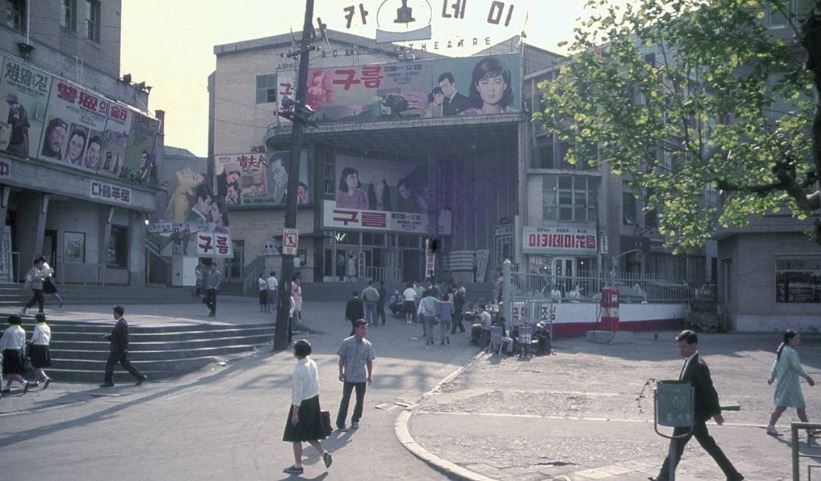SEJONG -- South Koreans born in 1969 or later cannot enjoy the old-age annuity benefits, paid by the national pension operator, for five years after they retire at the age of around 60.
As they have to wait until they turn 65 (the initial age regarded as a senior) to be classified as recipients under the rules, there could be a longer income vacuum, compared to those born before 1969.

A now-defunct movie theater in downtown Seoul in 1968 is shown in one of 13,000 pictures showing life in the 1950s and 1960s donated by two US Forces in South Korea servicemen to the National Archives Korea in 2017. Those born between 1955 and 1963 -- Korea’s baby boomers -- will start to officially become senior citizens from Jan. 1. (Yonhap)
Though it is possible for younger people (aged 50 or under as of 2019) to apply for early payouts, which start the age between 60 and 64, applicants in their 50s or younger must be retirees with no source of income. In addition, the early recipients have reduced payouts.
Over the past decade or more, doubts have grown as to whether salaried workers will really be given the amounts promised by the government when they hit pensionable age.
Further, there are prevailing rumors that the government is quietly seeking to raise that age from the current 65 to at least 68 or up to 70.
Some skeptics say that any such scheme should be preceded by an extension of statutory retirement age for the private sector from the current 60 to 65.
But there are those who criticize both, claiming that the policies would deprive young people of job opportunities. Others complain that it is basically a scheme to keep citizens working until they die.
A market insider alleged that the Finance Ministry and the Health and Welfare Ministry might be struggling to deal with the structural problems surrounding the payments into and out of the National Pension Fund.
According to the data held by the state pension operator, the number of incumbent policyholders, on a cumulative basis, is likely to fall in the coming years, meaning fewer people paying in.
Though the number increased from 20.74 million as of December 2013 to 22.31 million in December 2018, the latest figure (as of July 2019) slid by about 150,000 to 22.16 million.
While the number of subscribers paying pension premiums is estimated to have peaked, the number of pension recipients is rapidly climbing.
The number of recipients for the old-age annuity surged by 32.7 percent from 2.84 million in December 2013 to 3.77 million in December 2018. The figure further rose by 3.9 percent (or about 150,000 people) in only seven months to tally 3.92 million as of July 2019, and it is projected to exceed 4 million by the year-end.
This has brought worries of a possible depletion of the fund in the next few decades.
Currently, people aged 50-59 are taking up the largest proportion, 28.6 percent, of policyholders, followed by those in their 40s at 27.3 percent. In contrast, the figures for those in their 30s and those under 30 are just at 23.7 percent and 18.2 percent, respectively.
Some experts on demography share the view that the ongoing retirement of the Korean baby-boomer generation, born between 1955 and 1963 (or those aged 56-64), is a core threat to the financial soundness of Korea’s national pension funds.
They are calling for the society to reach a consensus on revamping the pension system as early as possible. But Health and Welfare Minister Park Neung-hoo has predicted the debates would be feasible after the 2020 general election, slated for April 15.
A demographic analyst said a significant point is how the government would placate young people and guarantee their stable receipt of annuity payments.
“Many online commenters demand an immediate refund of premiums,” he said. “They, in a furious or frustrated manner, say they don’t need interest but just want repayment of principal they have paid so far.”
The percentage of South Koreans in their 50s posted the largest with the number of 8.68 million as of November 2019, trailed by those in their 40s at 8.38 million.
The two generations accounted for 32.9 percent of the population, which means 1 out of every 3 Koreans are aged 40-59.
By Kim Yon-se (
kys@heraldcorp.com)






